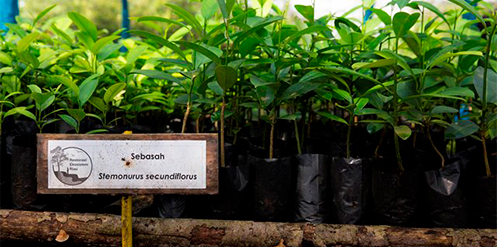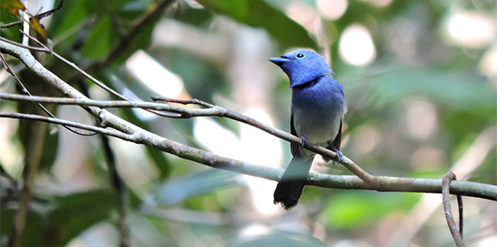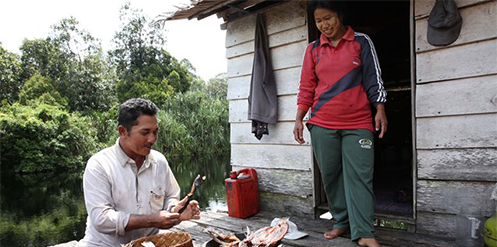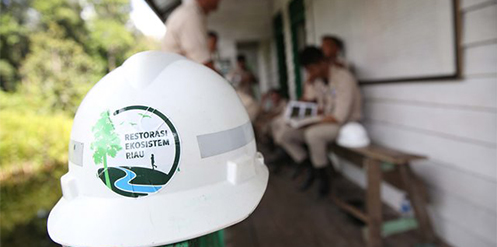May 29, 2018
In 2004 the Indonesian government initiated a new license opportunity for the private sector to help restore and conserve degraded forest through the newly-introduced Timber Forest Product Utilization License for Ecosystem Restoration, or IUPHHK-RE, which grant 60-year licences to restore the ecosystem balance of the forest while carrying out non-timber related commercial activities, such as ecotourism and carbon sequestration. The first license of this kind was issued to PT REKI in 2007 in South Sumatra. The government has set a target of 1.9 million hectares of degraded forest land to be allocated for Ecosystem Restoration.
RER was given its first licence in 2012 for an area covering 20,000 hectares, with another four licenses granted between 2013 to 2014 to bring the total area to its current 150,000 hectares.

As of May 2017 the government had awarded 16 IUPHHK-RE licences to projects covering 623,075 hectares, or about 34 per cent of its target.
The RER programme has five ecosystem restoration licenses under its management and has made some good progress – Since 2015, there has been no deforestation or fires, and RER has documented 300 bird species on the Kampar peninsula as compared to the 128 bird species identified during 1991/92 surveys that were used by Birdlife International in 2004 to establish the peninsula as an Important Bird Area (IBA). The reason for these positive results is that active protection, assessment, restoration and monitoring are occurring everyday in RER.
And many of the lessons learned over the last few years can be applied to similar projects in the region, according to RER Operational Head Brad Sanders.
Perhaps the biggest question with such a large project is that of where to start. To answer that, the RER team devised a four-pronged strategy to Protect, Assess, Restore and Manage the area.

Protect
One of RER’s first steps was to set up forest protection systems on the Kampar Peninsula which have prevented illegal logging, forest encroachment, fires and wildlife poaching incidents since 2015, resulting in the degraded forest being able to naturally recover.
As part of the system, permanent control points (in the form of guard posts) are established at the main access points in order to enforce rules and regulations. Forest protection teams are provided with the knowledge, training and equipment needed to perform their duties.
Assess
Meanwhile the assessment pillar aims to establish baseline data on biodiversity, carbon stocks and the social and economic wellbeing of surrounding communities. 718 species of plants and animals have now been documented in RER, including 300 bird species which were published in an annotated checklist recently.
Much of the area was unexplored by scientists prior to the establishment of RER, so proper assessment is vital in order to plan the work under the restoration pillar.
Restore
So far RER has replanted 30 hectares of degraded forest with tree seedlings grown in -established nurseries, while allowing less degraded sites to regenerate naturally.
This has been aided by the blocking of canals dug previously to facilitate illegal logging, which lower the water table and dry out the peat soil. Blocking the canals is painstaking work, with 30kg sandbags carried by hand through the forest, but the team has so far blocked off 25 per cent of the 116km of canals which have been mapped.
Manage
The Management pillar involves working with local communities in the area to ensure the RER project is sustainable in the long term. There are around 17,000 people living around the licence area in Kampar Peninsula and 24,000 people in Padang Island, many of whom traditionally depend on the forest to earn a living. RER has set up a number of programs to make local people partners in the project, whether as employees or contractors, or by providing training and equipment to enable them to conduct their traditional activities in a more sustainable manner.
While there are many lessons that can be applied elsewhere, Brad advises that there are also factors that make RER somewhat unique.
Involving the community
Forest degradation in Indonesia is usually caused by human activity, so specific actions are needed in this area, Brad says.
Ecosystem restoration projects must ensure the delineation of areas within the concession which will be prioritised for community use (such as cultivation) and forest restoration areas for biological and ecosystem balance, or wood production purposes.

Meanwhile, socialisation and constant communication with nearby communities who utilise the forest is essential to inform and actively engage them in the company’s legal responsibilities and efforts to protect and restore the forest, Brad says.
In doing so, projects like RER must formalise agreements with producers of non-timber forest products, such as honey farmers or fishermen, to ensure continued access to those products, and that legal or sustainable practices are used.
It is also vital that immediate and specific enforcement actions are taken against any violators who carry out illegal logging, forest encroachment, burning, poaching or the like, Brad adds.
“Take immediate action to document and report (forest violation incidents) to government authorities in order for legal enforcement actions to take place against the offending person or party,” he says.
More importantly, the project must be viewed by the community as bringing a benefit to the people and not as a hindrance to their livelihoods, Brad says.
To do so, alternative income opportunities for communities residing on community land must be developed in order to replace non-sustainable and harmful extractive use of forest products.
Examples of such opportunities are no-burn intensive vegetable farming, fish farming, livestock rearing, agro-forestry (vegetable crops mixed with rubber or other wood production tree species) and employment or contract labour.
Removing or mitigating human activity can make restoration easier, since allowing the forest to naturally regenerate where possible is more effective than manual replanting, both ecologically and economically.
“Forests can grow and recover if human disturbance is absent,” says Brad.
“Depending upon the intensity of forest degradation or deforestation, moisture, risk of human disturbance and time since last disturbance, natural regeneration is less expensive than active regeneration and may be more appropriate if seed sources or root stocks are available,” he says.

Part of the process is identifying those areas where active regeneration can be beneficial, such as areas where the forest is so badly degraded that natural seed stocks are limited.
Projects like RER must also understand that engagement and partnerships with supportive and active environmental or social organisations, in addition to various levels of government, are essential to gain understanding, acceptance and refinement of restoration activities.
“Without their active involvement, the project faces criticism from many directions,” Brad states.